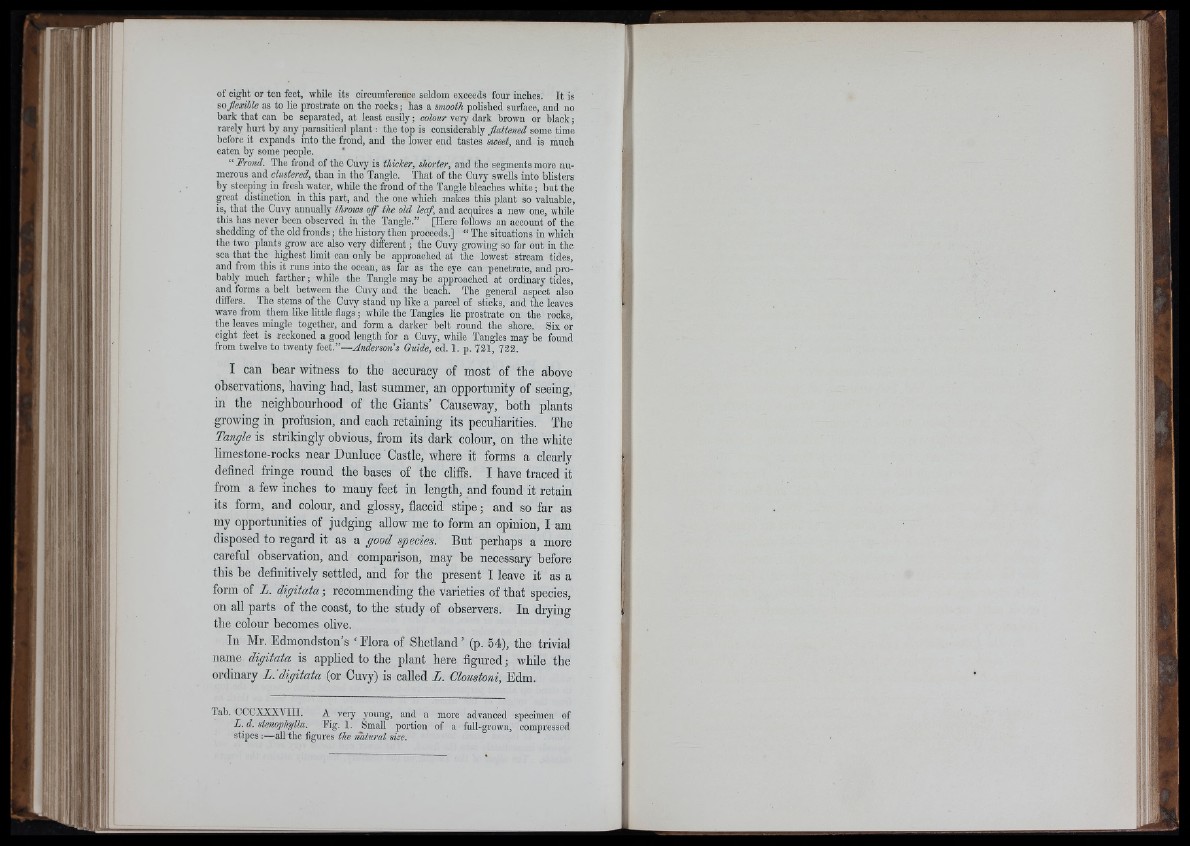
ill I
of eight 01- ten feet, while its circumference seldom exceeds four inches. I t is
so flexible as to lie prostrate on the rocks; has a smooth polished surface, and no
bark that can be separated, at least easily; colour very dark brown or black;
rarely hurt by any parasitical p lan t: the top is considerably flattened some time
before it expands into the frond, and the lower end tastes sweet, and is much
eaten by some people.
“ Frond. The frond of the Cuvy is thicker, shorter, and the segments more numerous
and clustered, than in the Tangle. That of the Cuvy swells into blisters
by steeping in fresh water, while the frond of the Tangle bleaches white; hut the
great distinction in this part, and the one which makes this plant so valuable,
is, that the Cuvy annually throws off the old leaf, and acquires a new one, while
tliis has never been observed in the Tangle.” [Here follows an account of the
shedding of the old fronds; the h isto ^ then proceeds.] “ The situations in which
the two plants grow are also very different; the Cuvy growing so far out in the
sea that the highest limit can only be approached at the lowest stream tides,
and from this it runs into the ocean, as far as the eye can penetrate, and probably
much farther; while the Tangle may be approached at ordinary tides,
and forms a belt between the Cuvy and the beach. The general aspect also
differs. The stems of the Cuvy stand up like a parcel of sticks, and the leaves
wave from them like little flags; while the Tangles lie prostrate on the rocks,
the leaves mingle together, and form a darker belt round the shore. Six or
eight feet is reckoned a good length for a Cuvy, while Tangles may he found
from twelve to twenty feet.”—Anderson’s Guide, ed. 1. p. 731, 733.
I can bear witness to tbe accuracy of most of tbe above
observations, having bad, last summer, an opportunity of seeing,
in tbe neigbbourbood of tbe Giants’ Causeway, botb plants
growing in profusion, and eacb retaining its peculiarities. Tbe
Tangle is strikingly obvious, from its dark colour, on tbe white
limestone-rocks near Dunluce Castle, where it forms a clearly
defined fringe round tbe bases of tbe clifis. I have traced it
from a few inches to many feet in length, and found it retain
its form, and colour, and glossy, flaccid stipe; and so far as
my opportunities of judging allow me to form an opinion, I am
disposed to regard it as a good species. But perhaps a more
careful observation, and comparison, may be necessary before
this be definitively settled, and for the present I leave it as a
form of L. digitata; recommending the varieties of that species,
on all parts of the coast, to tbe study of observers. In drying
tbe colour becomes olive.
In Mr. Edmondston’s ‘ Flora of Shetland ’ (p. 54), tbe trivial
name digitata is appbed to the plant here figured; while the
ordinary L. 'digitata (or Cuvy) is called L. Cloustoni, Edm.
Tab. CCCXXXYIII. A
very young.
L. d. stenophylla. Kg. I . ____
Small
stipes:—all the figures the natural size.
and a more advanced specimen of
portion of a full-grown, compressed
:i1
. / I
IH
■ . 'C"l
A
id